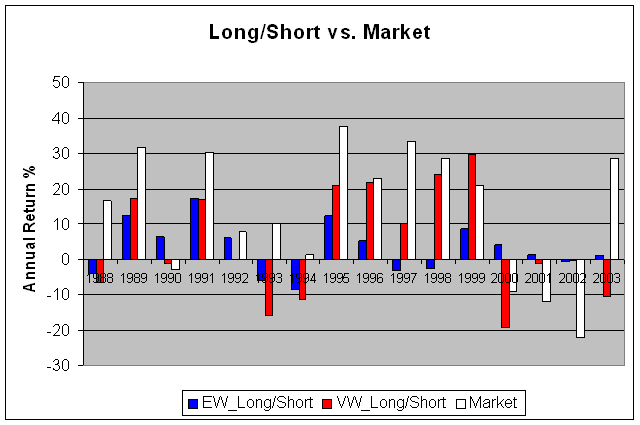3. 3-Year EPS Growth
Description of Factor:
The 3 year estimated EPS growth rate is
the consensus analyst estimate of the average annual growth rate in earnings
per share over the next three years.
The rationale behind this variable is the expectation that stocks that
have high estimated growth rates will outperform stocks with low estimated
growth rates. In contrast to the 1 Year
EPS Growth factor, we estimated that a three year growth rate would be a long
term, more sustainable indicator of a stock’s future performance. From an investment strategy standpoint, this
would imply a growth focused strategy rather than a value focused
strategy.
Analysis
Equal
Weighted: As shown in the graph
below, the quintiles have a relatively flat distribution of annualized average
returns. Quintile 1 generates the highest return of 18.67% and quintile 4 the
lowest with 15.62%. The return of
quintile 5 is only marginally higher than that of quintile 4 with 15.98%. The standard deviation for quintile 1 is
17.63% while it numbers 12.54% for quintile 5.
The average excess return of quintile 1 is (0.25)%
and (3.08)% for quintile 5. The beta for
quintile 1 is 1.13 with an R2 of 70%, while the beta for quintile 5
is 0.81 with an R2 of 71%.
Based on the
distribution of the annualized average returns among quintiles, a long-short
strategy is plausible. However, the
spread of annualized average returns between quintile 1 and 5 is small, less
than 300 basis points. This alone makes
this strategy challenging. Additionally, the annualized average return for the
highest returning quintile, quintile 1, is below the annualized average return
of the market. This means that on
average, a long-short strategy using the 3 year EPS growth rate would under
perform the market. Also, quintile 1
yields the highest return only six out of the sixteen years surveyed. Quintile 5 is the worst performing portfolio
in only four out of the sixteen years, while it is the best performing portfolio
three years. Similarly, quintile 1 is
the worst performing portfolio in four years.
Hence, implementing a long-short strategy would be disastrous since your
portfolios do not perform consistently.
The monthly turnover ratios are relatively low, 12.52% for quintile 1
and 12.43% for quintile 5.
Value
Weighted: Although the
distribution of the annualized average returns does not follow a step function
either, it is better than that of the equal weighted portfolios in as far as
that the spread between returns of quintile 1 and quintile 5 is greater. The
annualized average return for quintile 1 is the highest with 20.23% and the
return for quintile 5 is the lowest with 13.49%. The standard deviation for quintile 1 is
16.26% while it numbers 12.41% for quintile 5.
The average excess return of quintile 1 is 1.09% and (5.20)% for quintile 5.
The beta for quintile 1 is 1.14, while the beta for quintile 5 is
0.80.
Compared to
the equal weighted portfolio, the value weighted portfolio is better suited for
the implementation of a long-short strategy.
However, the excess return over the market, although positive for
quintile 1, is too low with only 1.09% above the market to compensate for the
risk taken. A closer inspection of the
actual rankings of the portfolios illustrates this fact. Quintile 1 yields the highest return in only
four of the sixteen years sampled while it generates the lowest return in six
of the years. Quintile 5 is the worst
performing portfolio in five years, but it is the best performing portfolio in
four out of the sixteen years.
Conclusion:
From our analysis above, we conclude that the 3 Year EPS Growth factor is not suited to implements a long-short strategy. The distribution of annualized average returns among the five quintiles is sufficient from a directional standpoint to be feasible. However, the spread of these returns between the highest and lowest ranking quintiles is too low to base a strategy upon. In addition, the lack of consistency in the rankings of the quintiles further diminishes the factor’s predictive power.



